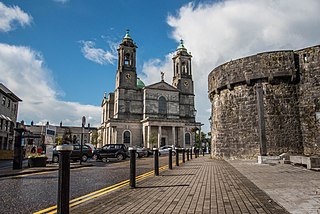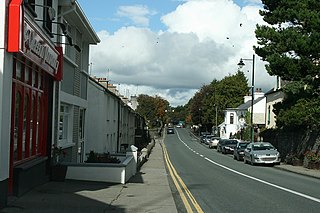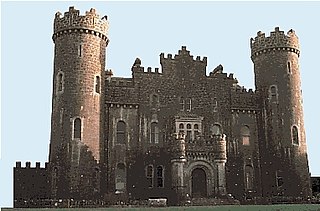Related Research Articles

Athlone is a town on the border of County Roscommon and County Westmeath, Ireland. It is located on the River Shannon near the southern shore of Lough Ree. It is the second most populous town in the Midlands Region with a population of 21,349 in the 2016 census.

Ballymahon on the River Inny is a town in the southern part of County Longford, Ireland. It is located at the junction of the N55 National secondary road and the R392 regional road.

Castlepollard is a village in north County Westmeath, Republic of Ireland. It lies west of Lough Lene and northeast of Lough Derravaragh and Mullingar.

Ballinasloe is a town in the easternmost part of County Galway in Connacht. Located at an ancient crossing point on the River Suck, evidence of ancient settlement in the area includes a number of Bronze Age sites. Built around a 12th-century castle, which defended the fording point, the modern town of Ballinasloe was "founded" in the early 13th century. As of the 2016 census, it was one of the largest towns in County Galway, with a population of 6,662 people.
Knockcroghery is a village and townland in County Roscommon, Ireland. It is located on the N61 road between Athlone and Roscommon town, near Lough Ree on the River Shannon. The townland of Knockcroghery is in the civil parish of Killinvoy and the historical barony of Athlone North.

Glassan or Glasson, also the Village of the Roses is a small village in rural County Westmeath, Ireland. It is 10 km (6.2 mi) north of Athlone, on the N55 national secondary road, not far from the shores of Lough Ree.

Termonfeckin or Termonfechin is a small village and townland in County Louth, Ireland. It is within the parish of the same name, and lies repeatedly 8 km (5.0 mi) north-east of Drogheda. The population of the village tripled in the 20 years between the 1996 and 2016 census, growing from 530 to 1,579 inhabitants.
Marist College is a secondary school for boys in Athlone, County Westmeath, Ireland.

Knockdrin is a townland and electoral division that is 5.6 kilometers northeast of Mullingar, in County Westmeath, Ireland. It is the home of the Westmeath Hunt, and its most notable building is Knockdrin Castle. The R394 regional road, the main Mullingar to Castlepollard route, runs through the area.

Clonyn Castle also known as Delvin Castle, is a Victorian country house situated in Delvin, County Westmeath, Ireland some 18 km from Mullingar along the N52. It is a square, symmetrical, two-storey castle-like building of cut limestone with four tall, round corner towers at each corner. The interior has a large two-storey hall with a gallery and arcading. It was one of the last Victorian baronial castles to be built in Ireland.

Sean's Bar is a pub in Athlone, Ireland, notable for its reputed establishment in AD 900, and claim to being the oldest extant bar in both Ireland and Europe. Other architectural and archaeological records, including the Record of Monuments and Places and the National Inventory of Architectural Heritage, date the building to the 17th or 18th century.
Sir James Dillon was an officer in the armies of the Irish Confederate Catholic during the Irish Confederate Wars (1641–53) and an MP for County Westmeath in the Irish House of Commons. He was likely born at Kilfaughny, Athlone and lived in the vicinity.

Ballymore is a village in County Westmeath, Ireland, on the R390 road between Athlone and Mullingar. The historic Hill of Uisneach is nearby. The village was known in medieval times as the medieval borough of Ballymore Lough Sewdy, or Loughsewdy, after the nearby lake, the site of an ancient bruighean, or hostel.

Mount Temple is a village in County Westmeath in Ireland, about 6.5 km northwest of Moate. It is noted for its golf course of the same name. It was historically called Ballyloughloe. Mount Temple and its 'sister' village, Baylin, form the only two in the parish of Ballyloughloe.

Ballynacargy, or Ballinacarrigy, is a small village in County Westmeath, Ireland on the Royal Canal and the R393 regional road. The last official commercial navigation of the canal took place in 1955.

Athlone Castle, sometimes known as Adamson Castle, is a castle located in Athlone, County Westmeath, Ireland, dating from the 12th century.
The High Sheriff of Westmeath was the British Crown's judicial representative in County Westmeath, Ireland from its creation under The Counties of Meath and Westmeath Act 1543 until 1922, when the office was abolished in the new Free State and replaced by the office of Westmeath County Sheriff. The sheriff had judicial, electoral, ceremonial and administrative functions and executed High Court Writs. In 1908, an Order in Council made the Lord-Lieutenant the Sovereign's prime representative in a county and reduced the High Sheriff's precedence. However the sheriff retained his responsibilities for the preservation of law and order in the county. The usual procedure for appointing the sheriff from 1660 onwards was that three persons were nominated at the beginning of each year from the county and the Lord Lieutenant then appointed his choice as High Sheriff for the remainder of the year. Often the other nominees were appointed as under-sheriffs. Sometimes a sheriff did not fulfil his entire term through death or other event and another sheriff was then appointed for the remainder of the year. The dates given hereunder are the dates of appointment. The following is an incomplete list: all addresses are in County Westmeath unless stated otherwise.
Garrett Dillon (c.1640-c.1696) was an Irish judge, politician and soldier, who held the office of Recorder of Dublin. He is mainly remembered today as one of the signatories of the Treaty of Limerick, which he helped to negotiate. The refusal of the Irish Parliament to ratify the Treaty led to his downfall. He fled abroad and died in exile in France.

The St. Mary's Church, Athlone is a Church of Ireland parish church situated in the town of Athlone, County Westmeath.
References
- ↑ "Portlick Castle, Portlick, Westmeath". buildingsofireland.ie. National Inventory of Architectural Heritage. Retrieved 19 January 2021.
- 1 2 Alistair Rowan, Christine Casey. North Leinster: The Counties of Longford, Louth, Meath and Westmeath.
- ↑ "Aussies Abroad, Luke Whitington", by Alex McGregor, Sydney Morning Herald, 28 January 1989; plus "Portlick Castle to give a big boost to tourism", article in The Westmeath Independent (date and author to be supplied).
- ↑ "Australian buys into 800 years of Irish heritage", by Steen Hanson, The Sunday Business Post, 28 May 1995.
- ↑ Historical account in Knight Frank Real Estate brochure, checked 22 April 2019.
- ↑ "Portlick Castle, Glasson, Athlone, Co. Westmeath". Archived from the original on 16 November 2012. Retrieved 17 December 2012.
- ↑ "Is your Ireland dream home a 12th-century haunted Irish castle". irishcentral.com. 8 April 2020. Retrieved 19 January 2021.
- ↑ "Family in California buys historic Portlick Castle". Westmeath Independent. Retrieved 23 October 2021.
- ↑ Tynan, Eithne (20 November 2014). "Proper castle with ghosts and dungeons can be yours for €1.9m". Independent.ie. Retrieved 4 March 2021.
53°29′43″N7°54′44″W / 53.4952°N 7.9121°W
California family Buys Historic Castle [1]
This castle was inhabited by the Finn Thor and Tora Hannevig and their family from approximately 1953-1970. Renovations were made to add laundry and electricity. Sources are extensive family photos from the period. They are buried at the local church. Finn Thor mentioned the Blue lady frequently.
